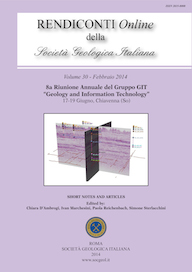
Landslide monitoring with an integrated platform: methodology, design and case study
Simone Frigerio (a), Luca Schenato (a), Giulia Bossi (a), Marco Cavalli (a), Stefano Crema (a), Matteo Mantovani (a), Gianluca Marcato (a) & Alessandro Pasuto (a)
(a) Research Institute for Geo-Hydrological Protection, Italian National Research Council, Corso Stati Uniti, 4 - 35127 Padova, Italy. E-mail: simone.frigerio@irpi.cnr.it
Volume: 30/2014
Pages: 24-27
Abstract
Landslide monitoring is usually linked to a complex physical system with several parameters and uncertainties. Different instruments are located and set up on field, but a simple, continuous and efficient integration is compulsory for an acceptable warning support.
The South-East flank of Mount Carega (Eastern Italian Alps) is affected by a complex landslide that, since 1985, is threatening Recoaro Terme. After the last re-activation on November 2010 (637 mm of intense rainfall recorded in the 12 days prior the event), a mass of approximately 320.000 m3 detached from the flank of Mount Carega and evolved into a fast debris flow that ran for about 4 km along the stream bed.
A real-time monitoring system was required to detect early indication of rapid movements, potentially saving lives and property. A web-based platform for automatic and continuous monitoring was designed as a first step in the implementation of an early-warning system. Measurements collected by the automated geotechnical and topographic instrumentation, deployed over the landslide body, are gathered in a central acquisition unit. After the calibration process, data are transmitted by web services on a local server, where graphs, maps, reports and alert announcement are automatically generated and updated. All the processed information is available by web browser with different access rights.
Keywords
Get Full Text